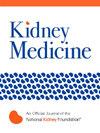Sleep Patterns, Symptoms, and Mortality in Hemodialysis: A Prospective Cohort Study
IF 3.2
Q1 UROLOGY & NEPHROLOGY
引用次数: 0
Abstract
Rationale & Objective
While sleep disorders are common in patients treated with hemodialysis, the impact of sleep patterns on survival is not well defined. We thus examined the association of specific sleep patterns with mortality in this population.
Study Design
An observational cohort study.
Setting & Population
In-center hemodialysis patients from the multicenter prospective NIH Malnutrition, Diet, and Racial Disparities in Chronic Kidney Disease (MADRAD) cohort.
Exposure
Sleep patterns ascertained using protocolized sleep surveys from March 2014 to June 2019.
Outcomes
Mortality.
Analytical Approach
Cox proportional hazards models.
Results
Among 452 participants, the mean age was 55±14 years, among whom 46% were women and the median follow-up was 3.5 years. In expanded case-mix models, shorter sleep duration (≤ median of observed values) was associated with higher mortality on dialysis and nondialysis days (ref: > median): HRs (95% CIs) 1.59 (1.09-2.31) and 1.51 (1.04-2.19), respectively. Patients who reported high frequencies (often/almost always) of difficulty falling asleep, feeling unrested, fatigue/exhaustion post-dialysis, or fatigue/exhaustion on nondialysis days had higher mortality (ref: never/rarely having these symptoms): HRs (95% CIs) 1.74 (1.17-2.58), 1.69 (1.1-2.5), 2.42 (1.41-4.16), and 1.73 (1.11-2.69), respectively. Moderate to high frequency of sleeping pill use was associated with higher mortality (ref: never/rare use): HRs (95% CIs) 2.07 (1.08, 3.97) and 2.00 (1.22, 3.28) for sometimes and often/almost always using sleeping pills, respectively. Sleeping outside of the primary sleep period (intra-dialytic sleeping and napping) was not associated with worse survival. However, patients reporting frequent apnea or restless legs syndrome had higher mortality.
Limitations
Potential recall bias, residual confounding, absence of time-varying observations, and limitations in generalizability.
Conclusions
In a well-characterized prospective multicenter hemodialysis cohort, patients who reported shorter sleep duration, sleeping difficulty or feeling unrested, moderate to frequent sleeping pill consumption, and sleep disorders (apnea and restless legs) had a higher mortality risk.
Plain Language Summary
Patients with kidney failure have a high burden of sleep disorders. However, the relationship between sleeping problems and the health of patients treated with dialysis is not well understood. To address this knowledge gap, we examined the relationship between various types of sleep disturbances and associated symptoms with survival among a diverse cohort of patients treated with hemodialysis from the multicenter prospective NIH Malnutrition, Diet, and Racial Disparities in Chronic Kidney Disease (MADRAD) study. We found that patients who reported shorter sleep duration, sleeping difficulty or feeling unrested, moderate to frequent sleeping pill consumption, and sleep disorders such as apnea or restless legs syndrome had a higher death risk.
理论依据& 目标虽然睡眠障碍在接受血液透析治疗的患者中很常见,但睡眠模式对生存的影响还没有得到很好的界定。因此,我们研究了特定睡眠模式与这一人群死亡率的关系。研究设计一项观察性队列研究。结果死亡率分析方法Cox比例危险模型结果在452名参与者中,平均年龄为55±14岁,其中46%为女性,中位随访时间为3.5年。在扩大的病例混合模型中,较短的睡眠时间(≤观察值的中位数)与较高的透析和非透析日死亡率有关(参考:> 中位数):HRs(95% CIs)分别为 1.59(1.09-2.31)和 1.51(1.04-2.19)。高频率(经常/几乎总是)报告入睡困难、精神不振、透析后疲劳/疲惫或非透析日疲劳/疲惫的患者死亡率较高(参考:从未/很少出现这些症状):HRs(95% CIs)分别为 1.74(1.17-2.58)、1.69(1.1-2.5)、2.42(1.41-4.16)和 1.73(1.11-2.69)。安眠药的中高频率使用与较高的死亡率有关(参考:从不使用/很少使用):有时使用和经常/几乎总是使用安眠药的 HRs(95% CIs)分别为 2.07(1.08,3.97)和 2.00(1.22,3.28)。在主要睡眠期以外的时间睡觉(透析中睡觉和打盹)与生存率降低无关。局限性可能存在回忆偏差、残留混杂因素、缺乏时变观察以及可推广性的局限性。结论在一个特征明确的前瞻性多中心血液透析队列中,报告睡眠时间较短、睡眠困难或感觉不安宁、中度至频繁服用安眠药以及睡眠障碍(呼吸暂停和不安腿综合征)的患者有较高的死亡风险。然而,人们对睡眠问题与透析患者健康之间的关系还不甚了解。为了填补这一知识空白,我们研究了美国国立卫生研究院(NIH)多中心前瞻性慢性肾脏病营养不良、饮食和种族差异(MADRAD)研究中接受血液透析治疗的不同人群中各种类型的睡眠障碍和相关症状与生存之间的关系。我们发现,睡眠时间较短、入睡困难或感觉不安宁、中度或频繁服用安眠药以及患有呼吸暂停或不安腿综合征等睡眠障碍的患者死亡风险较高。
本文章由计算机程序翻译,如有差异,请以英文原文为准。
求助全文
约1分钟内获得全文
求助全文

 求助内容:
求助内容: 应助结果提醒方式:
应助结果提醒方式:


